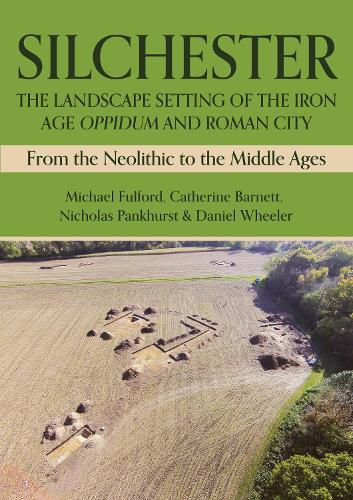Readings Newsletter
Become a Readings Member to make your shopping experience even easier.
Sign in or sign up for free!
You’re not far away from qualifying for FREE standard shipping within Australia
You’ve qualified for FREE standard shipping within Australia
The cart is loading…






The landscape setting of the Iron Age oppidum and Roman city of Calleva Atrebatum (Silchester) was initially explored through analysis of the available aerial photography and Lidar data over c. 1000 km2. Focusing on a 50 km square centred on Calleva, six locations with suspected later prehistoric enclosures were sampled by coring and excavation and accompanied by extensive programmes of radiocarbon dating and environmental, especially pollen analysis. Phases of activity and/or settlement were followed by abandonment and the regeneration of the woodland. Neolithic and Bronze Age activity was identified, but the first permanent settlements appeared to be of Late Bronze Age/Early Iron Age date. The period with the most numerous settlements is the Middle Iron Age (4th to 2nd century BC), which was characterised by hillforts and smaller ditched enclosures. Their abandonment was once again followed by woodland regeneration. At the end of the 1st century BC new settlements were founded, including the 38 ha defended oppidum in a wooded and otherwise empty landscape. A territory with a radius of c. 2 km and devoid of individual farmsteads was established around the oppidum to provide land for cultivation and grazing and it was retained with the founding of the Roman city. This territory corresponds approximately with the combined present-day parishes of Mortimer West End and Silchester. The charcoal assemblages show evidence for the management of the woodlands including for the preparation of charcoal from the Late Iron Age though the Roman and into the medieval period. Dated charcoal shows continued activity in the Environs in the post-Roman and early medieval periods including the re-occupation of the hillfort at Pond Farm. AUTHORS: Michael Fulford is Professor of Archaeology at the University of Reading. He has excavated extensively on the Iron Age and Roman town of Silchester. Catherine Barnett, formerly Senior Research Fellow and Research Manager, Silchester Environs Project, University of Reading is now Technical Director, Environment, Archaeology and Heritage, Stantec UK. Nicholas Pankhurst is Research Assistant at the University of Reading. Daniel Wheeler, formerly Research Assistant at the University of Reading, is now with Countryside Services, Hampshire County Council.
$9.00 standard shipping within Australia
FREE standard shipping within Australia for orders over $100.00
Express & International shipping calculated at checkout
The landscape setting of the Iron Age oppidum and Roman city of Calleva Atrebatum (Silchester) was initially explored through analysis of the available aerial photography and Lidar data over c. 1000 km2. Focusing on a 50 km square centred on Calleva, six locations with suspected later prehistoric enclosures were sampled by coring and excavation and accompanied by extensive programmes of radiocarbon dating and environmental, especially pollen analysis. Phases of activity and/or settlement were followed by abandonment and the regeneration of the woodland. Neolithic and Bronze Age activity was identified, but the first permanent settlements appeared to be of Late Bronze Age/Early Iron Age date. The period with the most numerous settlements is the Middle Iron Age (4th to 2nd century BC), which was characterised by hillforts and smaller ditched enclosures. Their abandonment was once again followed by woodland regeneration. At the end of the 1st century BC new settlements were founded, including the 38 ha defended oppidum in a wooded and otherwise empty landscape. A territory with a radius of c. 2 km and devoid of individual farmsteads was established around the oppidum to provide land for cultivation and grazing and it was retained with the founding of the Roman city. This territory corresponds approximately with the combined present-day parishes of Mortimer West End and Silchester. The charcoal assemblages show evidence for the management of the woodlands including for the preparation of charcoal from the Late Iron Age though the Roman and into the medieval period. Dated charcoal shows continued activity in the Environs in the post-Roman and early medieval periods including the re-occupation of the hillfort at Pond Farm. AUTHORS: Michael Fulford is Professor of Archaeology at the University of Reading. He has excavated extensively on the Iron Age and Roman town of Silchester. Catherine Barnett, formerly Senior Research Fellow and Research Manager, Silchester Environs Project, University of Reading is now Technical Director, Environment, Archaeology and Heritage, Stantec UK. Nicholas Pankhurst is Research Assistant at the University of Reading. Daniel Wheeler, formerly Research Assistant at the University of Reading, is now with Countryside Services, Hampshire County Council.